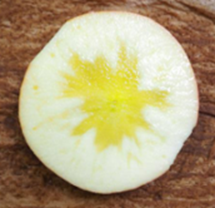NARO, in collaboration with Chiba University and Aomori Prefectural Industrial Technology Research Center, has identified the most probable candidate gene responsible for watercore disorder in apple and developed DNA markers that can predict apple cultivars that are susceptible to watercore. This research result will be useful in efficiently selecting cultivars that are resistant to watercore at the seedling stage itself and expected to elucidate the watercore formation mechanism in Fruit trees of the Rosaceae family, including apples.
Overview
In apple, watercore attributes to their rich aroma and considered to be an indicator of delicious fruit by many consumers both in Japan and overseas. However, storing of watercored apples for a prolonged period may lead to flesh browning and loss of its commercial value. It is believed that watercore occurs when sorbitol, a type of sugar, accumulates in the intercellular spaces, causing tissues to become water soaked. Some of the watercore-susceptible apple cultivars are "Fuji", "Haruka", and "Gunma Meigetsu", and resistant cultivars are "Ourin", "Kiou", and "Shinano Gold". However, it is known that the watercore occurrence is also influenced by the environment, such as the cultivation method, weather, and growing area.
A research group from NARO, Chiba University and Aomori Prefectural Industrial Technology Research Center, has analyzed the relationship between the watercore and genetic information using an unprecedentedly enormous number of samples. They identified the prominent candidate gene that may be responsible for the differences between the cultivars by comparing gene expression between the watercore-susceptible and resistant cultivars. This gene encodes a protein called Sugars Will Eventually be Exported Transporter (SWEET), which is responsible for the transport of sugars, and it has been shown that it may be involved in the accumulation of sorbitol.
Based on the knowledge obtained, the research group developed a DNA marker that can predict which individuals are more likely to receive watercore at the seedling stage. By using this DNA marker, it will be possible to efficiently develop apple varieties that easily retain watercore, suitable for early consumption after harvest, and varieties that are resistant to watercore, suitable for long-term storage. This will contribute to the year-round supply of apples. Furthermore, in Japanese pears and peaches, which belong to the same Rosaceae family as apples, "watercore disorder" is seen as an issue at production sites, as it reduces the quality of the fruit, including its taste. However, if the mechanism behind watercore disorder can be elucidated through this result, it is expected that this will lead to a solution to the watercore disorders.
Budget:
This study was supported by Ministry of Agriculture, Forestry and Fisheries of Japan "Smart Breeding Technologies to Accelerate the Development of New Varieties toward Achieving Strategy for Sustainable Food Systems, MIDORI" JPJ012037; Cabinet Office, Government of Japan, Cross-ministerial Strategic Innovation Promotion Program (SIP) "Technologies for Smart Bio-industry and Agriculture" and by the Japan Society of the Promotion of Science KAKENHI Grant Number JP20H02982.
 Watercored Fuji apple
Watercored Fuji applePublication
Kunihisa et al. (2024) Susceptibility of apple cultivars to watercore disorder is associated with expression of bidirectional sugar transporter gene MdSWEET12a. Scientia Horticulturae 334: 113297. https://doi.org/10.1016/j.scienta.2024.113297




